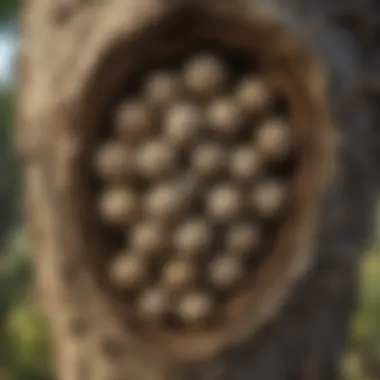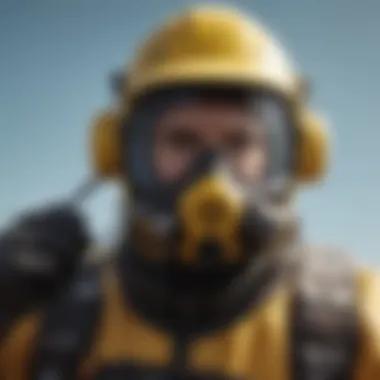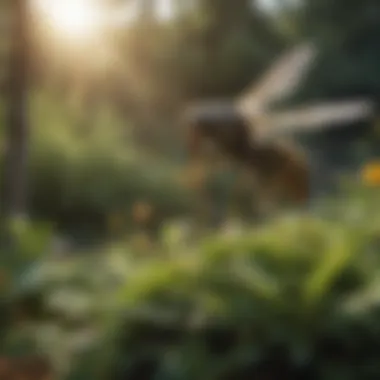Effective Techniques to Spray Wasps Safely


Intro
Dealing with wasps can be a daunting task, especially when they invade your outdoor spaces. Understanding the essential aspects of wasp control can protect you from painful stings and ensure your home remains safe. This article will offer practical techniques for spraying wasps, minimizing risks while maximizing effectiveness. By comprehending the behavior of these insects, using proper safety gear, and selecting the right timing for treatment, you can effectively manage your wasp problem. Let's delve into the critical components of wasp identification, prevention techniques, and DIY methods for control.
Understanding Wasp Behavior
Grasping the intricacies of wasp behavior is essential when attempting to manage their populations effectively. This comprehension helps homeowners navigate the complexities of dealing with these insects while reducing the likelihood of stings. The significance of understanding these behavioral patterns cannot be understated, as it informs every decision made in the process of spraying wasps.
Types of Wasps
Wasps exhibit a diverse range of species, each possessing unique characteristics and nesting preferences. Common types include the yellow jacket, paper wasp, and hornet. Yellow jackets tend to be aggressive and frequently scavenge for food, which often brings them into proximity with humans. Paper wasps, while less aggressive, can still pose a threat if they feel their territory is encroached upon. Hornets, belonging to the larger wasp family, are known for their potent stings and can be particularly defensive of their nests.
Understanding the type of wasp that is present is crucial. Different species may require varied approaches to spraying and control. For example, yellow jackets are often found in urban settings, whereas paper wasps prefer more secluded areas.
Wasp Nesting Habits
Another important aspect of wasp behavior involves their nesting habits. Most wasps build nests from paper-like material, which they create by chewing wood fibers mixed with saliva. These nests can commonly be seen hanging from eaves, in tree branches, or in hidden crevices.
Identifying the nesting location can significantly impact the spraying strategies chosen. Nests can range in size and structure, from small groups hanging under ledges to large, expansive colonies. Focusing efforts on nests that are active during specific times, such as late summer and early fall, can improve the effectiveness of spraying efforts, as adult populations peak.
Aggression Levels
Aggression levels among wasp species also play a role in determining how to approach them. Social wasps, like yellow jackets, exhibit a higher aggression level especially when their nests are threatened. They are more likely to sting in defense of their home. In contrast, solitary wasps, while they may still sting, usually only do so when provoked.
Recognizing the potential for aggression can shape how and when to spray. Timing the application when wasps are less active, like early morning or late evening, can reduce the risk of being stung. Also, approaching nests quietly and without sudden movements can further minimize confrontation.
Understanding the behavior of wasps provides critical insight. Choose the right approach based on their species, nesting habits, and aggression levels. This knowledge directly influences your safety during spraying.
Preparation for Spraying Wasps
Preparation is a crucial aspect when approaching the task of spraying wasps. Effective preparation can help ensure your safety and the success of your spraying efforts. Understanding the right steps increases your chance of effectively eliminating the wasp problem while reducing the risk of stings.
Safety Gear Essentials
Wearing the proper safety gear is the first line of defense you should employ. As wasps can become aggressive when their territory is threatened, investing in protective clothing is vital. Here are some recommendations for essential gear:
- Long sleeves and pants: Choose thick fabric to limit exposure. A tightly woven material helps prevent stings.
- Gloves: Opt for thick, long gloves that cover your wrists. They need to be resistant to stings, as wasps can target exposed skin.
- Face protection: A face shield or a beekeeper mask can protect you and ensure you can see clearly during the task.
- Sturdy footwear: Closed, thick shoes can prevent stings on your feet. Sneakers or boots are a good choice.
- Respirator mask (if needed): Depending on your insecticide choice, protection against fumes may be necessary.
Wearing the right safety gear is essential for minimizing risk during the spraying process. It allows you to focus on the task without distraction.
Choosing the Right Insecticide
Selecting an appropriate insecticide is critical. Not all sprays are equally effective for wasps. You should look for products that are specifically designed to target wasps and provide quick knockdown. When choosing:
- Read labels carefully: Ensure that the product mentions effectiveness against wasps.
- Opt for foam-based sprays: Foam adheres to nests and makes contact longer than liquid sprays, enhancing effectiveness.
- Consider wasp-specific insecticides: Brands like Ortho and Hot Shot offer products tailored for wasp control.
- Check safety features: Look for Eco-friendly options if you are concerned about environmental impacts.
The effectiveness of your chosen insecticide will directly influence your success in handling wasp infestations. Hence, it warrants significant attention during preparation.
Tools for the Job
Having the right tools at your disposal can make the spraying process safer and more efficient. Here are essential tools you will need:
- Sprayer: A pressurized or aerosol spray can is crucial for even distribution. Pressurized options allow you to target nests from a distance safely.
- Ladder: If the nest is in a high location, use a stable ladder to reach it safely. Ensure the ladder is secure to avoid accidents.
- Containers for disposal: Have a bag or a container ready for the disposal of the wasp nest post-treatment.
Having the proper equipment enhances your preparation and directly contributes to a more controlled and effective outcome during wasp treatment.


Important Note: All preparation activities should be conducted with caution. If the infestation is severe or nests are located in difficult-to-reach areas, consider seeking professional assistance.
Optimal Timing for Spraying
Timing plays a crucial role in effectively spraying wasps without getting stung. Understanding when to carry out the spraying can significantly reduce the risk of stings and increase the effectiveness of the treatment. Wasps, like many other insects, have specific patterns of behavior influenced by environmental factors such as light, temperature, and season.
Choosing the right time not only enhances safety but also improves the chances of eliminating the nest successfully. Spraying during the ideal conditions maximizes the efficacy of the insecticide and minimizes the risk of wasps becoming aggressive. Several specific elements and considerations come into play regarding optimal timing, which will be detailed in the following subsections.
Best Time of Day
The best time to spray wasps is during the late evening or early morning. At these times, wasps are generally less active and more likely to be in or near their nests.
- Early Morning: Spraying before the sun rises can be advantageous since it is cooler and wasps have not fully awakened yet. Most of them will still be in or around the nest, making it easy to target them directly.
- Late Evening: Similarly, just before sunset is another optimal time. As temperatures drop, wasps return to their nests to rest for the night. This reduces their flight patterns and aggression, thus providing a more favorable condition for spraying.
"Timing improves efficiency and safety when spraying wasps. Choose late evening or early morning to minimize risks."
Seasonal Considerations
Seasonal variations impact wasp behavior and activity. In the warmer months, like late spring through early fall, wasp populations are at their peak. Therefore, understanding these seasonal dynamics can guide your spraying strategy effectively.
- Spring: Wasps are in the process of establishing nests. They are less aggressive because their population is still small. This period is often suitable for early intervention.
- Summer: This is the peak season for wasp activity. Populations can become quite large, leading to increased aggression. If sprayers attempt treatment during this time, caution should be exercised, particularly later in the day when wasps are more active.
- Fall: As temperatures drop, wasps tend to become sluggish. They may be less aggressive, but at this time of year, nests may also be particularly large and numbers high. An assessment should be done before deciding on a treatment.
Techniques for Spraying Wasps
Understanding the best techniques for spraying wasps is crucial for successfully managing an infestation. This section addresses various methods that can be employed, each with unique advantages and necessary considerations. Proper technique not only increases the likelihood of effectively neutralizing wasps but also helps prevent painful stings to yourself and nearby individuals.
Direct Application Methods
Direct application methods involve targeting the nest or the wasps themselves with insecticide. This approach typically yields immediate results, as it directly impacts the wasps present at the time of application. When using this method, it is essential to approach the nest quietly and quickly, minimizing disturbance to the wasps.
- Identify the Nest Location: Knowing the exact location of the nest allows for better targeting. Always approach from a safe distance, as any sudden movement can agitate the wasps.
- Use Appropriate Insecticide: Choose a product labeled for wasps, as some insecticides are more suitable for bees or other insects.
- Aim for the Entrance: Direct the spray into the entrance of the nest, as wasps tend to be more active in this area. This increases the chances of contact with the insects.
Using a Wasp Spray
Wasp sprays are specially formulated insecticides designed to eliminate wasps from a distance. These sprays often have a long reach, allowing the user to stay at a safer distance from the nest or the wasps themselves. The following points highlight why wasp sprays can be effective:
- Extended Range: Many commercial wasp sprays have a spraying range of 15 to 20 feet, enabling you to eliminate wasps without a close encounter.
- Fast-Acting Formula: Most wasp sprays contain active ingredients that quickly incapacitate wasps upon contact. Ensure to follow the product instructions for optimal results.
- Night Application: If possible, apply the wasp spray during the evening when wasps are less active. This reduces the risk of disturbing the nest and provoking aggression.
Distant Application Strategies
Distant application strategies refer to methods that involve minimal risk to oneself while effectively managing the wasp population. These strategies can be utilized in conjunction with sprays or other methods:
- Use of Dusts: Insecticidal dust can be applied into the nest entrance, which allows the wasps to carry the substance deeper into the nest. This method is especially useful for aggressive nests, as it reduces the necessity of direct confrontation.
- Foams and Gels: These products expand upon contact, creating a barrier that traps the wasps. Applying them allows you to stand further away while still addressing the problem.
- Monitor and Retreat: After application, it is wise to monitor the area from a safe distance. Observe wasp activity and retreat if necessary until you are confident the treatment was effective.
Utilizing various techniques for spraying wasps maximizes success while minimizing risk, reinforcing the importance of strategy in pest control.
Post-Spraying Protocols
Implementing post-spraying protocols is critical after attempting to control wasp populations. A well-thought-out procedure can significantly reduce risks, ensuring that both the area and individuals remain safe. Understanding how to effectively assess the area and conduct safety checks is essential for effective wasp management. Without following these steps, not only can the risk of re-infestation remain, but the chance of accidental stings also increases.
Assessing the Area
After spraying, the first task is assessing the area where the wasps were present. This involves checking for any signs of activity. Look closely for any remaining nests or wasps that may have survived the treatment. Assess the surrounding environment to determine if the insecticide used might have affected other beneficial insects or wildlife.
- Observe for activity: Spend a few minutes watching the area for any new wasp activity. If none is observed, it might indicate an effective treatment.
- Inspect nests: Carefully examine nests to see if they look inactive. Any signs of movement in or around it may require additional treatment.
- Check for collateral damage: Assess the impact on non-target insects in the vicinity. It is vital to ensure that the spray did not cause harm to beneficial creatures in your yard.


This assessment is important as it informs the homeowner of the success of the spraying and highlights if further steps are necessary.
Safety Checks
Conducting safety checks after spraying is paramount. Even if the wasp population appears reduced, safety should always be a priority. Here are some recommended protocols:
- Wear protective clothing: Until you are sure that the area is safe, it's wise to keep on the safety gear worn during the spraying.
- Keep children and pets away: Ensure that these vulnerable groups maintain a safe distance while you evaluate the site.
- Ventilate the area: If spraying was done indoors or in enclosed spaces, allow for proper ventilation. This minimizes any chemical residues the insecticides might leave behind.
Regular safety checks can prevent accidents and maintain a safe environment following wasp control efforts.
Following post-spraying protocols diligently plays a significant role in effective pest management. It ensures that homeowners not only achieve their goal of controlling wasp populations but do so in a safe and responsible manner.
Dealing with Potential Stings
When confronting wasps, it is essential to appreciate the very real risk of being stung. Thus, understanding how to deal with potential stings is critical for anyone attempting to manage a wasp problem. Wasps can be aggressive, particularly when their nests are disturbed, making knowledge of first aid and professional help crucial.
First Aid Measures
If stung, taking prompt action can significantly reduce pain and complications. Here is a summary of first aid steps to manage a wasp sting:
- Remove the stinger: If a wasp has stung you, check for a stinger. Unlike bees, wasps do not leave the stinger behind. However, if you do see one, use a flat object, such as a credit card, to scrape it out. Avoid using tweezers as squeezing can release more venom.
- Wash the area: Clean the sting site with soap and water to prevent infection.
- Ice the area: Applying ice wrapped in a cloth to the sting site can reduce swelling and numb the pain. Hold it for 10-15 minutes at a time.
- Medication: Over-the-counter antihistamines like Benadryl can help alleviate itching and swelling. Pain relievers, such as ibuprofen, may also help reduce discomfort.
- Monitor symptoms: Keep watch for severe allergic reactions, such as difficulty in breathing, swelling around the face or throat, rapid pulse, or dizziness. These can indicate anaphylaxis, which needs immediate medical attention.
Taking these first aid measures seriously provides a straightforward approach. It is not just about treating a symptom; it is about ensuring overall safety when dealing with these insects.
When to Seek Professional Help
If symptoms worsen or if you experience any severe reactions after a sting, seeking professional help is advised. Here are some signs that indicate when it's time to contact a healthcare professional:
- Severe allergic reaction: Symptoms like hives, swelling, or trouble breathing require emergency assistance.
- Multiple stings: If you have been stung multiple times, especially by more than one wasp, the risk of a severe reaction increases.
- Infection signs: Redness, warmth, swelling, or oozing from the sting site may signal an infection. A doctor can prescribe the necessary treatment.
- Anxiety about wasps: If you feel overwhelmed or fearful about future wasp encounters, speaking to a pest control expert can provide peace of mind and preventive strategies.
In summary, while wasp management is important, knowing how to deal with potential stings can help minimize risks. Taking the right first aid measures can make a significant difference in your safety, and recognizing when to get professional assistance ensures that you are never left to manage a situation too dangerous on your own.
Environmental Considerations
Impact of Chemical Sprays
Chemical sprays, while effective for immediate elimination of wasps, can carry significant risks. These products often contain potent active ingredients that may affect non-target species, including beneficial insects like bees. When sprayed, chemical residues can drift and settle on nearby plants, impacting not only local flora but also the broader ecosystem.
Moreover, these substances can contaminate soil and water resources, leading to long-term environmental damage. Homeowners should be aware that persistent use of such chemicals poses risks not only to wildlife but also to children and pets that may come into contact with treated areas.
Homeowners must weigh the immediate benefits of wasp removal against the potential environmental consequences. Thoughtful application is critical; for instance, applying insecticides only when wasps are most active can help minimize unwanted exposure to other insects. Proper timing can mitigate some of the negative impacts on the ecosystem, but caution is still advised.
"Utilizing pesticides should be balanced with an awareness of their broader effects. We are stewards of our environment; our actions matter."
Sustainable Alternatives
As concerns about the environmental impact of chemical sprays rise, many homeowners seek sustainable alternatives for wasp control. Options like using homemade traps or natural repellents offer effective ways to manage wasp populations without extensive harm to the ecosystem.
For example, homemade traps can be made using common household items such as sugar water or fruit juice placed in containers. This method captures wasps without directly applying harmful chemicals. Additionally, many natural plant-based oils, such as peppermint or clove oil, can deter wasps without causing adverse effects on beneficial insects.
Adopting such eco-friendly methods aligns with a growing desire for sustainable living. This approach not only protects the environment but also promotes a healthier living space for families. In this way, sustaining the ecosystem while dealing with wasp infestations becomes possible without compromising safety and effectiveness.
Choosing sustainable alternatives reflects a broader commitment to environmental stewardship. Not only do these methods reduce adverse effects on wildlife, but they also foster a deeper awareness of the interconnectedness between humans and nature.
DIY Approaches to Wasp Control


DIY approaches to wasp control provide valuable options for homeowners wishing to handle wasp problems effectively and safely. Many people prefer these methods because they often involve common household items, are usually less expensive, and have a lower environmental impact than chemical sprays. Understanding these methods is essential for those who may not feel comfortable using commercial pesticides or who wish to take a more organic route in pest control.
Homemade Wasp Traps
Creating homemade wasp traps is a practical solution to manage wasp populations near your home. These traps can be made using simple materials, such as plastic bottles. The basic idea involves luring wasps inside while preventing their escape. Here’s how to make one:
- Materials Needed: You will need a plastic bottle, sugar water or fruit juice, and possibly some vinegar.
- Instructions: Cut the plastic bottle in half. Keep the top part with the cap. Invert the top part and place it back into the bottom half. This will create a funnel effect.
- Add Bait: Fill the bottom half with the sugar water or juice. Wasps are attracted to sweet smells, so they will be drawn to the trap. Optionally, you may add a bit of vinegar to help capture other insects as well.
- Placement: Set the trap in areas where you have seen wasps, such as near outdoor dining spaces.
These traps not only help in reducing wasp numbers but also pose a lower risk of stings since they can be placed away from where people often gather.
Natural Repellents
Natural repellents are another effective DIY approach to wasp control. Unlike chemical sprays, they are less harmful to the environment and safe to use around children and pets. Here are some natural options:
- Peppermint Oil: Wasps dislike the strong scent of peppermint oil. Mixing a few drops of peppermint oil with water in a spray bottle can create an effective deterrent. Spray this mixture around your home, particularly near areas where wasps frequent.
- Vinegar and Water Mixture: A solution of vinegar and water can also keep wasps away. The smell is unattractive to them, which helps to deter nesting near your property.
- Cucumber Slices: Place cucumber slices around areas where wasps are common. Many wasps are believed to avoid this vegetable due to its natural properties.
Using these natural repellents can be an intelligent strategy during outdoor activities. They provide a proactive measure to discourage wasps from invading spaces where people gather.
DIY approaches to wasp control can be safe, effective, and environmentally friendly. Taking these steps not only helps manage the insect population but also fosters a more pleasant outdoor experience.
Professional Pest Control Options
When it comes to managing a wasp infestation, professional pest control options can play an essential role in ensuring safety and efficiency. While some homeowners may think they can tackle the problem themselves, the risks involved can be significant. This section delves into why considering these services is critical, especially for those unfamiliar with safe pest control methods.
Engaging a pest control expert provides one with a wealth of knowledge and specialized skills. These professionals understand wasp behavior and the best practices to follow to minimize risk. Furthermore, they are equipped with industrial-strength spray solutions that are often more effective than off-the-shelf products. This is significant in dealing with established nests, where a targeted approach is required for maximum effectiveness. It is important to highlight that certain wasp species can be aggressive, making it perilous for inexperienced individuals to attempt removal.
When to Call Experts
There are several situations when contacting a professional might be necessary. If you identify a wasp nest that is large or located in a difficult-to-reach area, it is often prudent to seek help. Additionally, if anyone in your household has a known allergy to stings, the risks are compounded. Persistent wasp activity around your home or garden could also signify the need for expert intervention, as this can indicate a thriving population.
- Large or hard-to-access nests
- Known allergies within household
- Consistent wasp activity
Taking these factors into account can help you decipher whether it's time to reach out to a professional pest control service. A quick assessment will often save time and prevent potential harm later on.
Evaluating Pest Control Services
Once you decide to call in the experts, it is critical to thoughtfully evaluate the pest control services you consider. Not all pest control companies offer the same level of expertise or safety measures, so due diligence is essential.
Here are some pointers to guide your decision:
- Experience and Reviews: Look for companies with a proven track record. Client testimonials can provide insights into their effectiveness and customer service.
- Techniques and Products: Inquire about the methods they use and the chemicals involved. Ethical pest control companies should prioritize environment-friendly approaches and should be willing to discuss their products openly.
- Pricing and Transparency: A trustworthy service will provide clear pricing and be upfront about their procedures. Compare several estimates to find a balance between quality and cost.
Evaluating these factors can lead you to a pest control service that aligns with your needs and values, ensuring that any wasp issue is dealt with competently and safely.
Frequently Asked Questions
In this section, we will address common inquiries regarding wasp spraying. This will help clarify concerns and provide essential information for homeowners and pest control enthusiasts. Understanding these frequently asked questions can significantly reduce fear and uncertainty when dealing with wasp infestations.
How Effective is Wasp Spray?
Wasp spray effectiveness largely depends on several factors. The active ingredients in the spray, the proper application technique, and timing all contribute to success rates. Most commercial wasp sprays contain insecticides such as pyrethroids, which are designed to kill wasps on contact. These products work promptly and can eliminate multiple wasps in a single application.
It’s important to read and follow the manufacturer's instructions. Improper use may lead to lesser results. For instance, spraying from a distance is crucial. Doing this minimizes the chance of being stung, but it may also reduce effectiveness against some aggressive wasps. Wind can also impact the spray's trajectory, making it less effective if the breeze is too strong.
In general, when used correctly, wasp sprays can be quite effective for immediate control of a wasp problem, but persistent nests may require follow-up treatments.
Can Spray Wasps at Night?
Spraying wasps at night is often recommended. Wasps are less active in the evening and overnight, making them easier targets. At night, they usually return to their nests. Their reduced activity level means that there’s a lower chance of an aggressive response, which decreases the risk of being stung.
However, it is important to exercise caution. Visibility can be poor, and you should ensure the area is well lit to maintain control over your actions. Also, check the weather forecast. If rain is expected, it could wash away the spray, rendering it ineffective.
Effective and safe wasp management requires education, preparation, and care. Understanding the dynamics of wasp behavior and employing the right techniques can minimize risk and enhance control.















